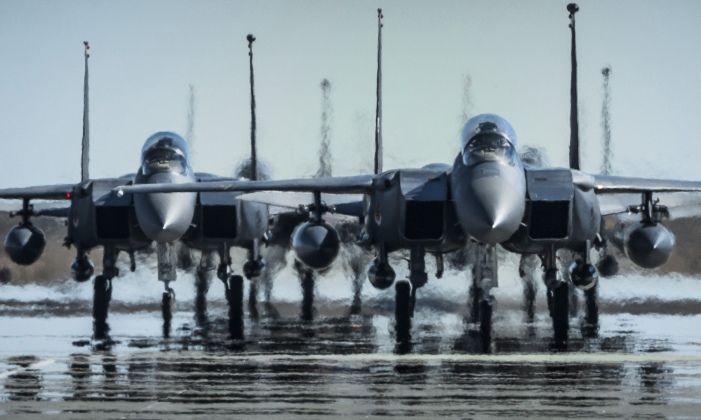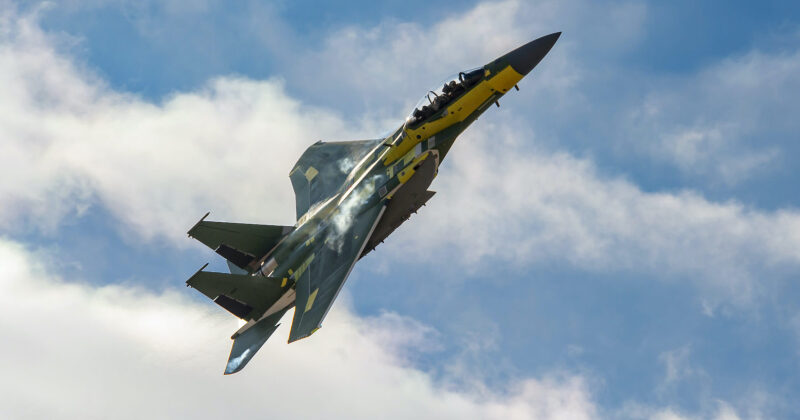Following the launching of an Iranian Revolutionary Guard Corps drone and missile strike under Operation True Promise on April 13, targeting Israeli military bases in retaliation for an Israeli attack on an Iranian diplomatic building in Syria twelve days prior, the United States Military was responsible for most of the claimed shootdowns of Iranian targets to protect its ally. While the operations of a pair of U.S. Navy Arleigh Burke Class destroyers in the Eastern Mediterranean have gained particular attention, and are credited with having made their first operational use of the SM-3 anti ballistic missile during the operation, F-15E Strike Eagle fighters are also credited with having played a very central role. U.S. Air Force F-15Es are deployed in the Middle East under the 494th Fighter Squadron and the 335th Fighter Squadron, which are permanently based at RAF Lakenheath in the United Kingdom and at Seymour Johnson Air Force Base in North Carolina respectively. Both units were deployed to the Middle East in the second week of October 2023 as part of a broader surge in the U.S. military presence in the region. This was initiated following the outbreak of open hostilities between Israeli forces and Palestinian militia groups in the Gaza Strip.

The F-15E is a primary workhorse of the U.S. Air Force, and is by far the longest ranged fighter class in the Western world. The aircraft is a heavily modified derivative of the F-15C/D Eagle air superiority fighter with a second seat, multiple conformal and external fuel tanks, and avionics better optimised for air to surface missions. The aircraft are less specialised in air to air combat than the F-15C/D, but are considerably more versatile and considered more than capable of engaging any class of combat aircraft fielded by Middle Eastern states. The 335th Fighter Squadron began to field the F-15E from early 1990, and the 494th from early 1992, replacing the Vietnam War Era F-4 and F-111 respectively. With the U.S. Air Force struggling to acquire a new enhanced derivative of the Strike Eagle, the F-15EX in numbers or on schedule, and with the country’s fifth generation F-22 and F-35 fighters having faced significant shortcomings in their reliability and availability rates, the F-15E is set to continue to be relied on heavily far into the future.

While the F-15 is by far the oldest fighter class in the world still in production, the F-15E has been modernised considerably with 21st century avionics and weaponry. One of the most notable enhancements has been the integration of the Raytheon AN/APG-82(V)1 active electronically scanned array (AESA) radar from the early 2010s, after the first U.S. Air Force squadron, an experimental F-15C/D squadron, became the world’s first to use AESA radars in 2000. From 2022 F-15Es have also been fitted with AN/ALQ-250 Eagle Passive/Active Warning Survivability Systems. A key facilitator of the F-15’s ability to integrate upgrades cost effectively is the airframe’s very long operational life of up to 16,000 with proper refurbishment, which is well over double that of older F-15 models. This combined with the fact that the Strike Eagles were built much later than other F-15s means the class can continue to serve for decades longer.
The F-15E is a significantly more capable fighter than any in the Israeli arsenal, other than its newly delivered F-35 fight generation fighters, and while Israel does deploy 25 modified F-15E derivatives designated F-15Is, these were produced in the 1990s and use mechanically scanned array radars today considered effectively obsolete. Despite its age, the F-15E is still considered an elite fighter and one of the most capable in the Western world, with its endurance, radar size, weapons payload and flight performance all far surpassing those of the F-16 and F-35 that form the backbone of the fleet today. This was reflected in the decision to rely on the aircraft to shoulder the bulk of responsibilities in the Middle East at times of high tensions, as well as the continued production of the class as the F-15EX decades after the U.S. Air Force lost interest in acquiring any other pre fifth generation fighters.
